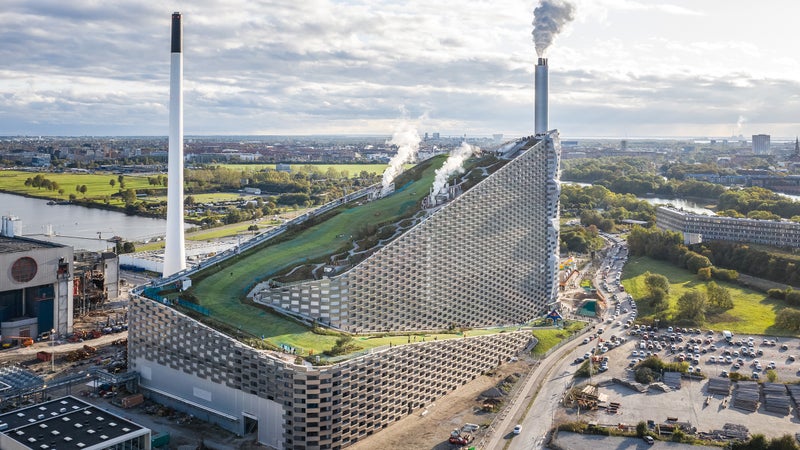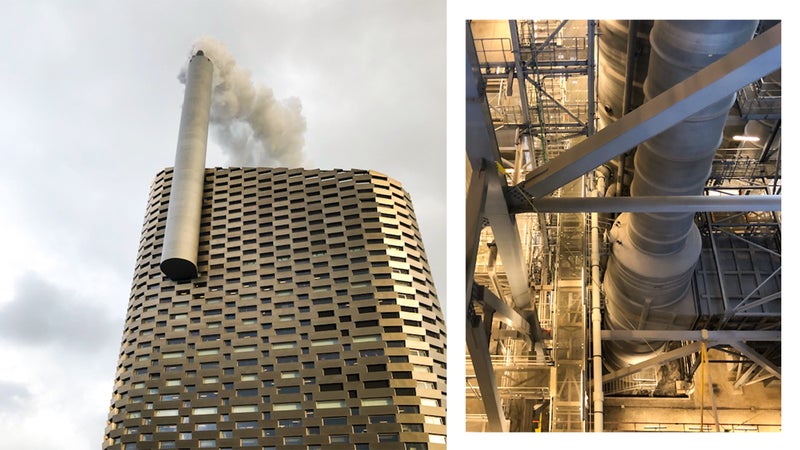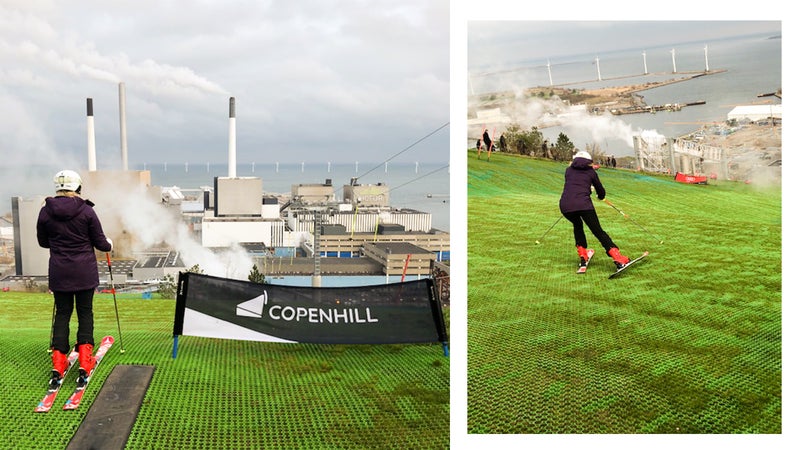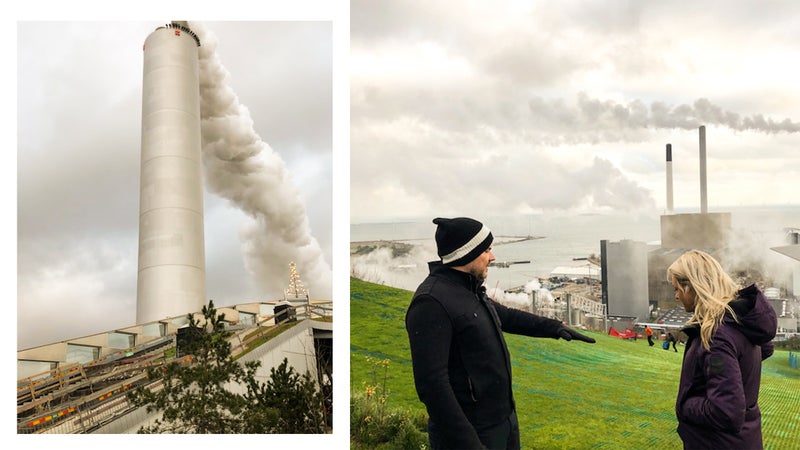Denmark Took a Mountain of Trash and Made a Ski Hill
Renowned architect Bjarke Ingels has crafted an epic synthetic slope on top of a massive waste-to-energy plant
New perk: Easily find new routes and hidden gems, upcoming running events, and more near you. Your weekly Local Running Newsletter has everything you need to lace up! .
On a cold, windy December day in Denmark, Amager Bakke might look, at least through severely fogged goggles, like any other ski slope. Near the top, helmeted skiers slalom down steep black-diamond runs, while at the bottom, headphone-wearing snowboarders hit jumps and rails. An instructor schools children in the art of the pizza wedge, while two friends giggle after one takes a tumble near the safety netting. At the nearby lodge, people enjoy glasses of après-ski glogg.
Wipe the goggles, and a whole other reality emerges. Amager Bakke, or CopenHill,��as it’s been dubbed, is a 462,848-square-foot waste-to-energy plant—which just happens to have a ski slope on its roof—rising like a glittering aluminum iceberg from the flat plains of a semi-industrial section of Amager (pronounced, inexplicably, “am-ah”), an island that comprises part of��the city of Copenhagen.
Standing at the 279-foot summit of what is now one of the city’s tallest structures presents a surreal spectacle: skiers whooshing down a vast carpet of green Neveplast, a synthetic “dry skiing” surface from Italy, amid��a staggering��panorama��that’s��dominated by the smokestacks of nearby biomass plants and, behind them, the gloomy, fog-shrouded expanse of the North Sea, dotted with massive wind turbines. Like the writer Don DeLillo’s “postmodern sunsets,” it’s at once inspiringly beautiful and vaguely apocalyptic.
Walking around the windswept peak, I run into Chemmy Alcott, a now retired English ski racer and four-time Olympian, who’s filming a segment for the and has just completed a run on silicone-coated skis (a required lubricant on CopenHill).
“It’s really quite epic,” she says. No stranger to artificial snow, she tells me that she finds the stubbier Neveplast faster than she’s used to. “It’s not boring,” she said of Amager Bakke, praising the “undulating terrain” and the strange experience of skiing through the vaporous plumes of steam being vented by the plant. “For a moment��you lose awareness, and then you come out the other side,” she says. “It’s like when you skydive and go through a cloud.”

CopenHill, which, along with the plant below, is owned��by�� (ARC),��offers more than skiing. You can simply hike to the summit on the marked trail��for the best view in Copenhagen, stopping to admire the wild strawberries growing on landscaped sections to one side of the slope (where a fox was recently spied). You can also run that path up (there’s already a Strava segment).��If you’ve any gas left, there are CrossFit bars at the top. “Last weekend we had a race with 450 people dressed as Santa Claus,”��Cecilie Nielsen, CopenHill’s head of customer relations, tells me. “It was awesome.”
Come spring, one of the world’s tallest climbing walls, a twisting and weaving ascent, will open��on a corner of the building, which will eventually��be laced with green��as the structure’s built-in aluminum window boxes begin to bloom. And, lest they forget why they are there, climbers, as they traverse along the holds, will get occasional views into the plant itself,��where soaring apses support��the huge and complex workings that turn Danish garbage into Danish heat and electricity.
That a��cutting-edge waste-to-energy facility��now also boasts the best skiing in Denmark—call it the powder plant—is thanks to native son Bjarke Ingels, one of the world’s best-known architects��and an espouser of a way of thinking he’s called “sustainable hedonism,” a near oxymoronic philosophy that dares to ask the question: Can saving the world be fun?
Ingels seems to have a thing for roofs.
When I first met him in Copenhagen in 2006, we were standing atop a building he’d designed along with his former business partner, Julien De Smedt. Called the , it serves as��a sailing club with a youth center. Lacking outdoor space, the architects fashioned the roof into a swooping, skateboard-park-like deck.
Strolling through the vast range of his subsequent work that was on view at the this past fall, this seeming penchant for upward��thinking was on abundant display—from residential projects like the Mountain��in Copenhagen��(a building that happens to look like a mountain)��or Stockholm’s 79th and��Park,��whose roof is comprised of terraces, many planted with greenery,��to the in-progress design for the new Oakland A’s stadium, which features a tree-lined linear park running along a curved covering that dips toward the ground. The projects of the�� (BIG)��often look like dramatic staging grounds for some extreme sport or another (to take one example, the proposed Google campus in Sunnyvale, California), so it’s��small wonder that��Ingels—and some of his work—appeared in a film about parkour.
When I ask Ingels, as we sit in the Denali��conference room inside the waste-to-energy plant beneath the ski slope, if any sort of line can be drawn between the small-scale Maritime Youth House and the huge CopenHill, he smiles. “In a very literal way, there is the idea of doing things you’re not supposed to do on the roof,” he says. “But more fundamentally, there’s this idea that if we’re going to do something, we might as well do it the most exciting way possible.” This is a man, after all, who once compared his architecture to a game of Twister, which only becomes fun—more “acrobatic and enjoyable”—as you start “pouring on more demands.”

The idea of a hill loomed, by necessity, early in the project. The engineers, Ingels says, had dictated a basic envelope for the building, based on the machinery inside. “It was this kind of tiered series of blocks that got taller,” he says, like an ascending stereo-equalizer display. “The diagram was already mountainesque.”
Initially, BIG��added “the simplest kind of sloping roof,” adorned with a rooftop park. But he felt they were “staying in the realm of cosmetics,” like “putting lipstick on a pig.” He wondered if they could do something more transformative. On a site visit, Ingels noticed the nearby Copenhagen Cable Park, which whizzes wakeboarders around the harbor via overhead wires. “It just became so clear: the skiers had already arrived, but only in the summer.”
That part of Copenhagen wasn’t hurting for open space, but what it lacked—what the entire country lacked—was an enticing ski hill. “You have to drive four hours to Isaberg, in Sweden,” he says. “And Isaberg is not a very large mountain. The main slope is only a 150-meter [492-foot] drop. So it dawned on us that we could actually do two-thirds of a real mountain ski slope.” It seemed far-fetched at first. They talked to a ski-resort operator. They talked to Team Denmark, an elite-sports organization. No one told them it couldn’t be done, if only because no one had done it. “We started getting an understanding that we couldn’t actually shoot the idea down.”
Not that it was easy. As Jesper Boye Anderson, a designer at BIG, had told me in the firm’s Brooklyn offices: “You don’t open the code books and then look how to do a ski slope on top of a waste-burning plant.”
In one unconventional twist, the building is designed so that, in the event of a fire or an explosion, the walls will give way before the roof, as a safety measure for the skiers up top. The company, too, had to get the topography right from the get-go. “Once you mount concrete slabs,” Andersen��said, “you’re kind of locked on the geometry.” On top of those slabs, a layer of soil was attached, on which grass was planted��to cushion skiers’ falls and help with drainage. On top of that��went��the Neveplast panels, and��skiers’ blades trim��the grass that��pokes through.
But BIG’s architects didn’t like the joints between the seven-by-five-foot��panels, which could expand with warm weather. “You’re afraid that you’ll get your skis caught in the joints,” Andersen��said. So the company’s R&D wing, BIG Ideas,��working with Neveplast, created nearly invisible joints within the pattern itself, so it’s one long carpet of ski surface, 107,000 square feet of upturned hairbrush.
One of the things that attracted ARC’s��CEO to BIG’s proposal, Ingels believes, “is that it makes blatantly obvious something that would otherwise be completely invisible.” The company’s former waste-to-energy plant, located just next door and currently being dismantled, was hardly on anyone’s radar. And a new facility, even one that claims to be one of the most efficient garbage-burning��facilities of the world—part of Copenhagen’s seemingly achievable goal of being carbon-neutral by 2025—would hardly be a bucket-list destination for most people.

To make itself known, says Ingels, “they would have to make ad campaigns��or shout it from the rooftops.” Now, he says, people see it—its towering apex and steamy stack is hard to miss anywhere in town—and note that “it’s clearly something different, and, wait, how come there’s a ski hill? And then you start learning the story.” It becomes “a way to communicate what’s great about this power plant compared to others,” he says.
So far, it’s working. Since opening in October��2019, CopenHill has hosted a constant stream of media and foreign delegations (that afternoon, according to a screen in the lobby, South Korea’s environmental minister was scheduled to visit), not to mention tourists, who come to ski, hike the hill, or merely gawk and take selfies by the thousands. It’s easily the world’s most Instagrammed waste-to-energy plant, a virtual advertisement for itself.
There are actually two mountains at Amager Bakke.
One is the 1,312-foot-long��ski run, with its black, green, and blue sections. It’s a festive, daytime world, with breathtaking views.
The other mountain is a mountain of trash, cloying and festering, that lurks deep inside the structure, fed by the 200 to 300 garbage trucks that visit the facility each day. Sune Scheibye, ARC’s communications point man, takes me to the best place to view this towering, ever shifting aggregation: a��small control room, normally empty, where an engineer��sitting in a massive swivel chair worthy of the bridge of the USS��Enterprise��silently tracks the performance��through a large glass window, as��a set of automated cranes move clumps of debris from one side of the huge chamber to another. I feel like I’m living in The Terminator, and Skynet is definitely winning.
“It looks like one of those kids’ games, where you have to try to grab a prize with the claw,” I offer��to one of the men, who is terse and sober��in that Scandinavian way. “Except in this game, you actually grab something,” he says, cracking the smallest of smiles. “But not something you want to take home, by any means.”
From here, the trash is fed into one of two massive furnaces, each burning at 1,832 degrees Fahrenheit, an otherworldly orange glow visible through small glass portals. “The ash is used to build roadbeds,” Scheibye says. In 2018, the heat that was generated powered district heating for 70,000 homes in Copenhagen, while steam-powered turbines generated electricity for another 32,000.��Much of the plant is occupied by a series of huge,��twisting tubes and silos, which scrub more than 95 percent of the various noxious elements contained in the smoke.
The plume—mostly steam, with a touch of CO2—that gushes from the peak of CopenHill looms like a perpetual beacon on the city skyline. Ingels, working with the Berlin-based artists’ group Realities:United, had a thought, early on in the process, to have the emissions come out in giant smoke rings. “The idea was, if we could express that the plume was not this kind of toxic thing of the past,” he says. The project’s principals weren’t willing to fund this extravagance, but they weren’t exactly opposed to it either. So BIG, working with a local professor of airflow and turbulence, constructed a functioning one-third-scale prototype��fed by a ring of 24 nozzles. But a change in the project’s management put the idea on the back burner. “I said, ‘OK, let’s open the ski slope, celebrate some successes, and then we’ll try to get it done.’”

For Ingels, the smoke rings were a sort of living, breathing symbol of his philosophy of sustainable hedonism, “like smoking a cigar and puffing��smoke rings,” he laughs. At the same time, it could serve as a potent symbol of the environmental gains being made. “I was thinking it could be linked to an emission count—let’s say every time we’d reduced the emissions of CO2 by a ton, or 100 tons, or whatever, by replacing the old power plant with this one, it would be celebrated by puffing a ring.” Like a contemporary twist on a church bell, it would playfully signal social gains.
Much of the discourse around sustainability has become��almost inescapably freighted with negativity, he argues. “Either scaring people into action��or this kind of Protestant idea of taking cold showers. We felt that’s not very desirable.” But what if a sustainable life could also be a more enjoyable life? “That would be so much more powerful,” Ingels says.��
It’s become a rather common urban trope for the cast-off products of industrialization to be turned into contemporary sources of pleasure and ennoblement; think of London’s Tate Modern, housed in the former Bankside Power Station,��or New York City’s High Line, an arterial park fashioned from a defunct stretch of elevated freight rail. “We thought,��What if you don’t have to wait until they shut the power plant down before you make it enjoyable?”
That plant’s machinery, as one , will, too,��be obsolete in a number of decades, replaced, one hopes, by ever more efficient technology. “But he was quite certain that, in the end, the building will last,” Ingels says, “not because of its core purpose��but because of these extra ideas that we invented.”
Standing at the windswept summit of CopenHill, where a Christmas tree glittered daintily next to the towering smokestack, its grayish-silver silhouette nearly the same brooding color as the Danish sky, I felt as if I were neither quite fully in nature nor quite fully in the city, like I was��inhabiting a new space pried open by the human imagination. Nursing a knee injury, I—sadly, reluctantly—didn’t want to test myself on the fast (and new��to me) Neveplast. Instead I watched the surreal sight of skiers as they pushed off and slalomed down toward��a watery strait��ringed by industrial��buildings. That sentence upsets our normal mental geographies��and doesn’t quite make sense at first, but then again, neither did a ski slope on top of a giant trash incinerator.


